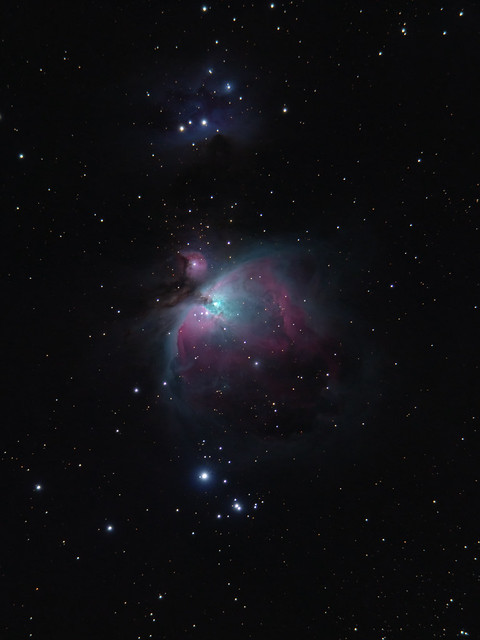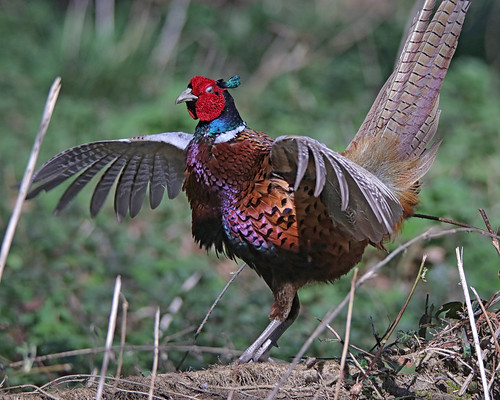There are a few notable exceptions however, and for northern hemisphere observers, the consensus seems to be that Messier 51 (commonly known as the Whirlpool Galaxy) is the best of the bunch. It resides some 25 million light-years away in the constellation of Canes Venatici (the Hunting Dogs), and can be found high overhead on spring evenings near the tail of the Great Bear (Ursa Major).
Here's a photo I took (actually forty-three 90-second exposures, stacked together) in March, showing the spiral very clearly:
 |
| M51 & NGC 5195, 28 Mar 2019; Canon EOS 80D + Tele Vue-60 + Vixen Super Polaris |
For a larger crop, see the version on my Flickr page.
Sixty-five minutes' worth of sensor data is one thing, but how much of that detail can you actually see with your own eyes? M51 and its interacting companion NGC 5195 are easy enough to spot through even a small scope, but it wasn't until I got the 10-inch reflector that I was able to see them as more than a pair of faint fuzzy blobs. Even then, the detail was elusive, with the dark spaces between the Whirlpool's arms often more apparent than the arms themselves.
My sketching skills are very rusty so it took me three attempts before I got something I was happy with, but here's an approximation of what M51 looks like through a medium-sized scope on a good night:
For this I used the 10-inch Orion XT10 and a Tele Vue Nagler 9mm eyepiece, giving a magnification of 133x.
Depending on the quality of your night sky, you may be able to see M51's spiral with a smaller telescope. I was never able to make it out with my 4-inch refractor (although the two galaxies themselves were obvious), and even with the XT10 I can't always see it, as demonstrated by these excerpts from my observing notes:
19 May 2018 (first night out with the new scope; sky a little hazy)
Not well placed (wrong side of meridian), but both galaxies showed bright cores. Strong hint of spiral arm structure, and a star superimposed over the face of the galaxy (not a supernova!).
10 February 2019 (cold, but not freezing; sky transparency improved considerably once the crescent moon got out of the way)
In a night of highlights, M51 was the undoubted stand-out. After staring at it for a couple of minutes I suddenly realised I could see the spiral arms quite clearly, defined by the dark space separating them. One arm curling out from core region around a foreground star. A magnificent sight at 133x, even though it was still some way from the zenith. With averted vision it started to look like a ghostly monochrome photo.
31 March 2019 (slightly chilly, windy with occasional strong gusts; transparency good, but not up to the standard set on 10 Feb)
Tonight M51 and NGC 5195 had an almost ghostly aspect about them; the spiral arms seemed to fade in and out of existence independently of averted vision. The view wasn’t substantially improved at 240x, other than highlighting some of the brighter areas with a milky glow.
4 April 2019 (chilly, gusty evening; excellent seeing, transparency improving as night went on)
Best view of spiral structure since 10 Feb; showed particularly well in averted vision. Dark areas between arms just about visible in direct vision. Also found a faint, round little galaxy roughly south of M51 – not plotted in the Pocket Sky Atlas, but later identified as NGC 5198.
(If you're into this sort of thing and you want to read more of my observing notes, I'm in the process of putting them online at https://mskastro.blogspot.com/ )
The visibility of the spiral is very sensitive to sky conditions, so if you don't succeed on one night, try again on another (and make sure your eyes are fully dark-adapted). Patience and persistence are vital. And here's another tip: if M51's spiral still seems maddeningly faint, steer your scope to the other side of the Great Bear's tail and see what you make of the larger (and fainter) spiral galaxy M101. Trust me, when you return to M51 it will seem positively bright by comparison.
So now you have an idea of what it takes to see the spiral in M51, but what about resolving individual stars in this beautiful galaxy? For that I recommend taking a very deep dive into this image by the Hubble Space Telescope...







